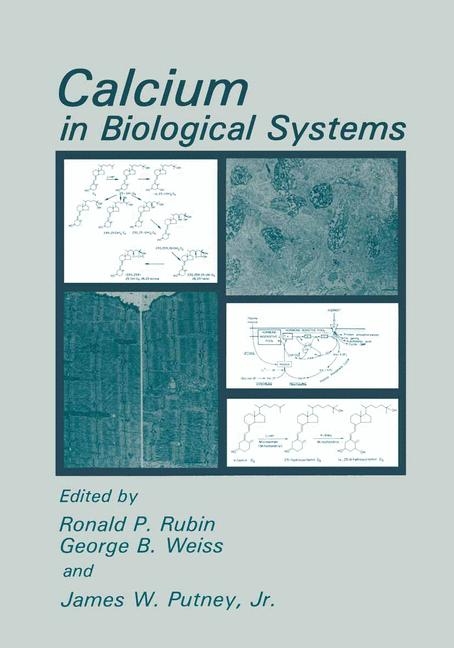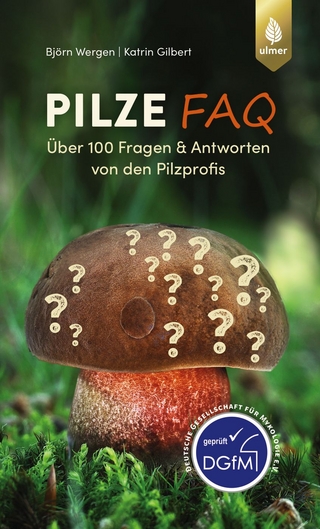
Calcium in Biological Systems
Kluwer Academic/Plenum Publishers (Verlag)
978-0-306-41747-4 (ISBN)
- Titel ist leider vergriffen;
keine Neuauflage - Artikel merken
A. Metabolic and Functional aspects of Calcium Action.- I. General Aspects of Calcium and Cell Function.- 1. Historical and Biological Aspects of Calcium Action.- 2. Calcium Ion: A Synarchic and Mercurial But Minatory Messenger.- 3. Intracellular Calcium as a Second Messenger: What’s so Special about Calcium?.- II. Roles of Phosphoinositides in Calcium-Regulated Systems.- 4. Calcium-Mobilizing Receptors: Membrane Phosphoinositides and Signal Transduction.- 5. Platelet Response in Relation to Metabolism of Inositides and Protein Phosphorylation.- 6. Receptor-Mediated Changes in Hepatocyte Phosphoinositide Metabolism: Mechanism and Significance.- 7. Hormonal Regulation of Phosphoinositide Metabolism in Rat Hepatocytes.- 8. Implication of Phosphoinositides in Receptor-Mediated Stimulation of Phospholipid Labeling.- 9. Calcium and Receptor-Mediated Phosphoinositide Breakdown in Exocrine Gland Cells.- III. Stimulus-Secretion Coupling.- 10. Calcium and Stimulus-Secretion Coupling in Pancreatic Acinar Cell.- 11. Glucose Regulation of Insulin Release Involves Intracellular Sequestration of Calcium.- 12. Role of Calcium in Stimulus-Secretion Coupling in Bovine Adrenal Medullary Cells.- 13. Calcium and Transmitter Release: Modulation by Adenosine Derivatives.- 14. The Role of Calcium and Osmosis in Membrane Fusion.- IV. Calcium Regulation of Hemopoietic Cells.- 15. Activation and Desensitization of Receptors for IgE on Tumor Basophils.- 16. Relationship between Calcium, Arachidonic Acid Metabolites, and Neutrophil Activation.- 17. Receptor-Controlled Phosphatidate Synthesis during Acid Hydrolase Secretion from Platelets.- 18. Calcium and Diacylglycerol: Separable and Interacting Intracellular Activators in Human Platelets.- 19. Protein Phosphorylation and Calcium as Mediators in Human Platelets.- 20. Na+ and Ca2+ Fluxes and Differentiation of Transformed Cells.- V. Calcium as a Regulator of Membrane Permeability.- 21. Calcium-Activated Potassium Channels in Bullfrog Sympathetic Ganglion Cells.- 22. Electrophysiological Evidence for Increased Calcium-Mediated Potassium Conductance by Low-Dose Sedative-Hypnotic Drugs.- 23. Neurochemical Studies on the Effects of Ethanol on Calcium-Stimulated Potassium Transport.- 24. Role of Calcium in the Regulation of Sodium Permeability in the Kidney.- VI. Calcium as a Regulator of Neuronal Function.- 25. Neuronal Calcium as a Site of Action for Depressant Drugs.- 26. Sedative-Hypnotic Drugs and Synaptosomal Calcium Transport.- 27. Barbiturate and Opiate Actions on Calcium-Dependent Action Potentials and Currents of Mouse Neurons in Cell Culture.- 28. Effects of Depressant Drugs on Sodium—Calcium Exchange in Resealed Synaptic Membranes.- 29. Calcium Extrusion by Retinal Rods Modifies Light Sensitivity of Dark Current.- 30. Mechanisms of Pharmacologically Altering Calmodulin Activity.- 31. The Purified Calcium-Pumping ATPase of Plasma Membrane: Structure-Function Relationships.- 32. Calmodulin-Binding Proteins That Control the Cytoskeleton by a Flip-Flop Mechanism.- 33. Calmodulin-Sensitive Adenylate Cyclase Activity: Interaction with Guanyl Nucleotides and Dopamine.- 34. Calcium/Calmodulin-Dependent Protein Phosphorylation in the Nervous System.- 35. Calcineurin, a Calmodulin-Stimulated Protein Phosphatase.- B. Calcium and the Regulation of Muscle Contractility.- VIII. Calcium and Skeletal Muscle Contractility.- 36. Calcium Channels in Vertebrate Skeletal Muscle.- 37. Mechanisms of Calcium Release in Skinned Mammalian Skeletal Muscle Fibers.- 38. Isotropic Components of Antipyrylazo III Signals from Frog Skeletal Muscle Fibers.- 39. Ion Movements Associated with Calcium Release and Uptake in the Sarcoplasmic Reticulum.- IX. Calcium and Cardiac Contractility.- 40. Role of Calcium in Heart Function in Health and Disease: 100 Years of Progress.- 41. Calcium Both Activates and Inactivates Calcium Release from Cardiac Sarcoplasmic Reticulum.- 42. Routes of Calcium Flux in Cardiac Sarcoplasmic Reticulum.- X. Calcium and Calcium Antagonists in Smooth Muscle.- 43. Calcium and Myogenic or Stretch-Dependent Vascular Tone.- 44. Chemical Skinning: A Method for Study of Calcium Transport by Sarcoplasmic Reticulum of Vascular Smooth Muscle.- 45. Cellular and Subcellular Approaches to the Mechanism of Action of Calcium Antagonists.- 46. Calcium Antagonist Effects on Vascular Muscle Membrane Potentials and Intracellular Ca2+.- 47. Suppression of Experimental Coronary Spasms by Major Calcium Antagonists.- 48. CGP 28392, a Dihydropyridine Ca2+ Entry Stimulator.- XI. Calcium Entry Blockers and Disease.- 49. Role of Ca2+ in and Effect of Ca2+ Entry Blockers on Excitation-Contraction and Excitation-Secretion Coupling.- 50. Calcium Antagonists in the Treatment of Arrhythmias.- 51. Calcium Entry Blockers in Coronary Artery Disease.- 52. The Use of Calcium Entry Blockers in Congestive Heart Failure.- C. Nutritional and Pathophysiologic Aspects of Calcium Action.- XII. Vitamin D and Other Calcemic Agents.- 53. The Vitamin D-Calcium Axis—1983.- 54. Vitamin D and the Intestinal Membrane Calcium-Binding Protein.- 55. Calcium-Binding Protein in the Central Nervous System and Other Tissues.- 56. The Vitamin K-Dependent Bone Protein and the Action of 1,25-Dihydroxyvitamin D3 on Bone.- 57. Prostaglandins as Mediators of Bone Cell Metabolism.- 58. Interactions of Calcemic Hormones and Divalent Cation Ionophores on Fetal Rat Bone in Vitro.- XIII. Alterations in Calcium Metabolism and Homeostasis.- 59. Altered Cell Calcium Metabolism and Human Diseases.- 60. Dietary Calcium in the Pathogenesis and Therapy of Human and Experimental Hypertension.- 61. Calcium Intake and Bone Loss in Population Context.- 62. Similarities and Differences in the Response of Animals and Man to Factors Affecting Calcium Needs.- 63. Factors Influencing Calcium Balance in Man.- 64. Role of Dietary Calcium and Vitamin D in Alveolar Bone Health: Literature Review Update.- XIV. Normal Biological Calcification.- 65. Normal Biological Mineralization: Role of Cells, Membranes, Matrix Vesicles, and Phosphatase.- 66. The Role of Collagen and Phosphoproteins in the Calcification of Bone and Other Collagenous Tissues.- 67. Biological Processes Involved in Endochondral Ossification.- 68. Role of Lipids in Mineralization: An Experimental Model for Membrane Transport of Calcium and Inorganic Phosphate.- XV. Pathological Calcification.- 69. Factors Contributing to Intracavitary Calcification.- 70. Mineral, Lipids, and Proteins Associated with Soft Tissue Deposits.- 71. Polymer Properties Associated with Calcification of Cardiovascular Devices.- 72. Calcification of Cardiac Valve Bioprostheses: Host and Implant Factors.- 73. Pathogenesis of Valve Calcification: Comparison of Three Tissue Valves.- 74. Noninvasive Imaging of Dystrophic Calcification.- 75. Prevention of Arterial Calcium Deposition with Diphosphonates and Calcium Entry Blockers.- XVI. Crystal Deposition.- 76. Arthritis and Calcium-Containing Crystals: An Overview.- 77. Nucleoside Triphosphate (NTP) Pyrophosphohydrolase in Chondrocalcinotic and Osteoarthritic Cartilages.- 78. Nucleation and Growth of CPPD Crystals and Related Species in Vitro.- 79. Biological Effects of Calcium-Containing Crystals on Synoviocytes.- 80. Rotator Cuff Tendinopathies with Calcifications.
| Erscheint lt. Verlag | 1.2.1985 |
|---|---|
| Zusatzinfo | 84 Illustrations, black and white; XXVI, 738 p. 84 illus. |
| Verlagsort | New York |
| Sprache | englisch |
| Gewicht | 1497 g |
| Themenwelt | Sachbuch/Ratgeber ► Natur / Technik ► Naturführer |
| Naturwissenschaften ► Biologie ► Biochemie | |
| ISBN-10 | 0-306-41747-2 / 0306417472 |
| ISBN-13 | 978-0-306-41747-4 / 9780306417474 |
| Zustand | Neuware |
| Haben Sie eine Frage zum Produkt? |
aus dem Bereich


